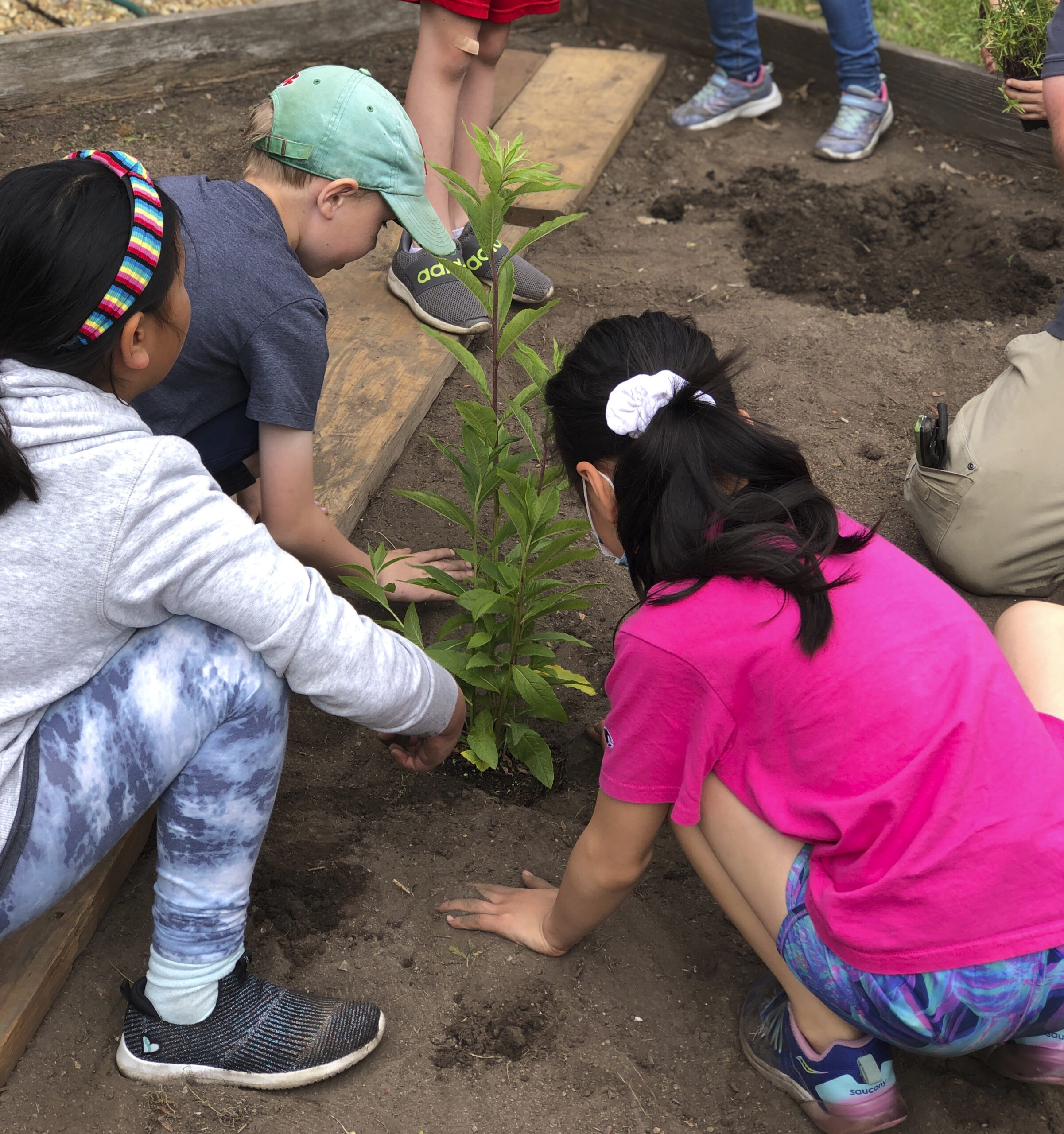Bowman School Pollinator Garden

TEXT BY: E. Ashley Rooney
PHOTOS BY: Peter Lund
Teaching young students to become stewards of the environment.

On Friday May 27, Rosanne Barbacano’s Room 11 gardening experts worked with Trevor Smith from Weston Nurseries and students in Kindergarten and other Grade 2 classes to plant over 15 varieties of native plants in the Bowman School garden space (located at the flagpole side of the school).
There were squeals when the students found a grub, contented “ahs” when they smelled the mint plant; and great excitement about being superheroes who were saving the bees.
In the 90s, teacher Steven Levy (a published educator) had a garden at Bowman. He grew and harvested wheat there! Upon departing from Bowman, Steven Levy “left” the garden plot to his successor Rosanne Barbacano to incorporate into her classroom studies.
Over the years, the garden project “fit in well” with her grade 2 science units. “I began to ‘weave’ the realization of Bowman’s Pollinator Garden into my science teaching of the “Nature’s Partners” unit,” she explains. Her “dream project,” as she describes it, was to start a “Pollinator Garden” at Bowman. “I realized that a Bowman Pollinator Garden would provide both—meaning, curricular connectivity, and enhancement to Bowman’s landscape,” Rosanne says.
Pollinator Gardens are a relatively new response to the decline in pollinator species (especially bees). Because the decline is closely associated with the loss of habitat, planting gardens rich with yummy nectar and pollen is a small effort to remedy the damage caused by agribusiness and chemicals.
Rosanne connected with Gardening Expert Trevor Smith, the Design and Education Manager at Weston Nurseries. Smith is an award-winning landscape designer, holding several landscape certifications, including MCH, NOFA AOLCP, LEEDGA, and IPCI, and a past President of the Ecological Landscape Alliance and a current Trustee.
Smith was willing to work with Rosanne’s class to help create a Pollinator Garden at Bowman.
The garden is about a lot more than bees and butterflies. Rosanne’s second-grade students have worked hard to understand pollinators and why plants need pollinators. Two students, Katie and Sara, told me that they learned new vocabulary words like pollination, nectar, and larva!
The second-grade curriculum unit is titled “Nature’s Partners.” Rosanne wanted to keep the second graders engaged, motivated, and agents of change as they solved the problem of making a home for pollinators.
Barbacano describes the student’s enthusiasm during Trevor Smith’s first classroom. She explains that seeing and recognizing many native plants and critters bred enthusiasm and engagement. “Student ecologists became convinced that native plants can help familiar and local plants, animals, and other organisms to work together to stay alive.”

The students researched over 20 varieties of native plants considering native plant height, light, and soil requirements. Meanwhile, regenerative landscape designer Trevor Smith presented a webinar to the Bowman PTO in preparation for the Pollinator Garden. He continued to assist Room 11 gardeners with the design and plan for the 16’3” by 12”5” garden.
They decided to plant the pollinator plants listed in the table below. This program has allowed the young gardeners to learn about classification, life cycles, and the relationship between plants and butterflies in pollination and reproduction.
Beyond providing sustenance for their six-legged friends, Trevor and the second grade pollinator activists want everyone to know how the Bowman Pollinator Garden plays a substantial (very important) role in rebuilding the local ecosystem and helps create climate resilience (for example, strengthening our native plants means cleaner air for us). Students created posters to send the message to the Lexington Community to support native plants.
“The best teaching and education allows student agency alongside the enthusiasm and expertise of gardening expert, Trevor Smith. As a classroom teacher, I just provided the “steering,” a proud Rosanne Barbacano notes with satisfaction.
NATIVE PLANTS
Start planning your spring garden with pollinators in mind.
- Allium cernuum Nodding Onion
- Asclepias incarnata- Swamp Milkweed
- Asclepias tuberosa- Butterflyweed
- Chelone glabra- White Turtlehead
- Eutrochium fistulosum-Joe Pyeweed, Trumpetweed
- Lobelia siphilitica-Blue Cardinal Flower
- Monarda fistulosa-Wild Bergamot
- Monarda punctata-Spotted Beebalm
- Penstemon digitalis-Beardtongue
- Vernonia noveboracensis-New York Ironweed
- Agastache Scrophulariaefolia-Purple Giant Hyssop
- Pycnanthemum tenuifolium Narrowleaf Mountain Mint
- Rudbeckia fulgida ‘Little Goldstar’-Black Eyed Susan
- Carex pensylvanica-Pennsylvania Sedge
- Rosa carolina L. Carolina Rose, Pasture Rose
Note: We include this list so everyone can take advantage of the second graders research into plants that would help the pollinators, particularly the bee.
